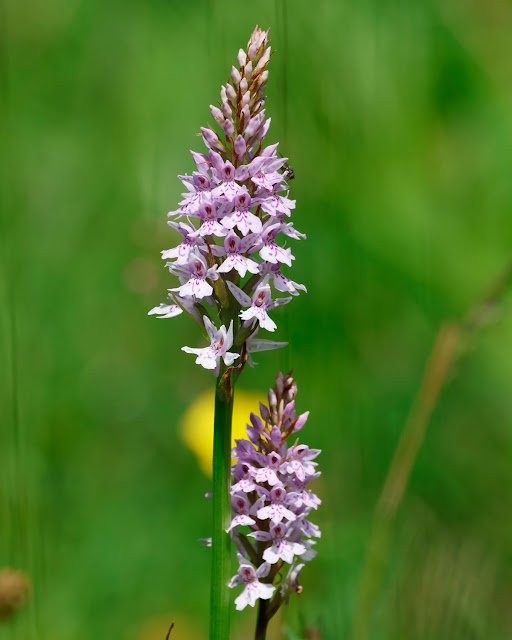|Ian and I met up at the parking place alongside the A325 at Broxhead Common. It was a glorious morning for once with blue skies and warm sunshine. We were here to find a butterfly specialty of the heath, the Silver-studded Blue, some years they can be seen in large numbers, but over the last few years they have been found to be down in numbers.
We set off over the heath with no sign of any butterflies, there were though moths and this Common Heath Moth settled on the heather to show off its lovely feathery antennae.
Close by was a female, the antennae not so flamboyant.
At the back of the common there is a pond, so it is no surprise to see dragonflies, this Four Spot Chaser posing beautifully on this dead Bracken stem.
The heathland looked perfect for a Nightjar and as we were talking about them we heard one churr. We turned back and slowly walked through the bracken. Ian scanned the trees and amazingly picked one out settled on a branch. This was the first view.
A little closer.
We think this was a female, through size and the lack of dark markings on the shoulder of the wings.
Here you can see the hairs around the bill that help with catching insects.
Unlike the two I saw in the New Forest, this one hardly moved, it shook itself once, but returned to the same position.
Last month was the first time I had ever managed to see a Nightjar settled, they have always been in flight, or flushed from the ground. This year I have seen three!
We walked away from the Nightjar and almost immediately came across our first Silver-studded Blue, a male settled on the Bell Heather.
This small butterfly is found mainly in heathland where the
silvery-blue wings of the males provide a marvellous sight as they fly low over
the heather. The females are brown and far less conspicuous but, like the male,
have distinct metallic spots on the hindwing.
The males are blue with a dark border. Females brown with a
row of red spots. Undersides are brown-grey with black spots, a row of orange
spots, and small greenish flecks on outer margin.
We could hear the song of at least two Woodlark around the heath, this one singing from the top of a dead tree.
While actually at the pond there were more Four-spot chasers.
From Broxhead we made the short trip to Noar Hill, once again we were after orchids, something that Noar Hill had plenty of. However in the first quarry just past the entrance to the reserve we came across a Small Blue and Brimstone butterfly.
The orchid we were here for was the Musk Orchid, a rather small orchid, the spike only reaching about 15 centimetres tall and easily lost amongst the grass, but once you got your eye in they were easily spotted and were everywhere. In the UK this rare orchid is now confined to the southern
part of England where it lives in short, cropped grass on chalk or limestone
habitats.
The flowers are very small and greenish-yellow, bell-shaped
and project downwards from the stem. They have a strong honey scent and are
very attractive to the tiny insects that cross-pollinate them. Musk Orchid is
also able to reproduce vegetatively and the plants grow several new tubers at
the end of tiny rhizomes which extend up to 20cm from the parent plant.
Another very common orchid at this site is the Common Twayblade, again these could be seen everywhere, but most had passed over flowering, I was though able to find some still with decent flowers.
The Common
twayblade is a medium-sized orchid that can be easily overlooked despite being
one of our commonest species. Common in the woodlands, scrub and grasslands of
chalky soils, its flower spike carries a very loose cluster of yellow-green
flowers that are not as showy as some of the other, more exotic-looking
orchids. It is in bloom from May to July.
The Common twayblade has a pair of broad leaves that appear
flush to the ground in March, before the flower stem grows. The single green
flower spike bears the yellow-green flowers that look a little like tiny
people. The stems can carry up to 100 flowers.
The Common twayblade is related to the much rarer, Lesser
twayblade, which grows on moorland and in wet woodland. Both are named after
their 'twin blades': Common Twayblade has two broad, rounded leaves that grow
near the base of the plant, while Lesser Twayblade has two heart-shaped leaves
in the same place.
As I mentioned, Noar Hill is covered in orchids, with Pyramidal
And Common Spotted Orchids almost everywhere.
Just before leaving I decided to turn over a strip of felt and underneath was a very nice Slow Worm.
The very first time I have ever found anything under one of these strips.
As we left there was a group of Yellow Broomrape. This is a parasitic plant lacking chlorophyl that grows on the roots of others.
Another great day, yet another Nightjar and two more new orchids.

_MG_8662.jpg)
















_MG_8980.jpg)















No comments:
Post a Comment